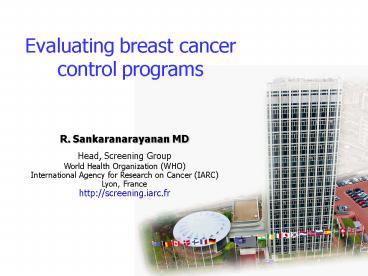Evaluating breast cancer control programs - PowerPoint PPT Presentation
1 / 20
Title:
Evaluating breast cancer control programs
Description:
Breast cancer/benign tumour detection rates. Process measures for screening test quality ... Breast cancer deaths similar in both groups ... – PowerPoint PPT presentation
Number of Views:145
Avg rating:3.0/5.0
Title: Evaluating breast cancer control programs
1
Evaluating breast cancer control programs
R. Sankaranarayanan MD Head, Screening
Group World Health Organization
(WHO) International Agency for Research on Cancer
(IARC) Lyon, France http//screening.iarc.fr
2
Monitoring Evaluation
- Process measures
- Participation in screening
- Screening quality
- Screen positivity
- Compliance with referral
- Breast cancer/benign tumour detection rates
3
Process measures for screening test quality
- with radiographically acceptable mammograms
(?97) - undergoing a technical repeat screening test
( - undergoing additional imaging at the time of
screening examination ( - of women recalled for further assessment
Perry et al., Annals of Oncology 200819614-622
4
Monitoring EvaluationIntermediate outcome
measure
- of screen detected cancers that are invasive
(90) - Stage distribution
- Proportion of women with breast cancer ? 2 cms
- Proportion of node negative barest cancer
- Proposition of ER ve tumours
- Proportion of patients completing the prescribed
course of treatment - Proportion of cancers treated with breast
conservation - Case fatality rate
- 2 and 5 year survival rates
5
Monitoring EvaluationFinal outcome measure
- Incidence rate of early and advanced cancers
- Mortality from breast cancer in both arms
- Adverse events
- Quality of life
6
Sources of data
- Program database
- Population based cancer registry
- National population identity registers
- Mortality registration offices
- Deaths records from other source (e.g. insurance)
- House visits
7
Randomized trial of breast self-examination in
shanghai (1989-1991) 1/2
- Women born between 1925 1958
- Randomized women on basis of 519 textile
factories - Intervention group
- 132 979 women
- intensive training in breast self-examination
- two subsequent reinforcement sessions and
multiple reminders to practice the technique - Control group
- 133,085 women
- training sessions on the prevention of low back
pain - All women followed for the development of breast
diseases and for death from breast cancer
Thomas et al., J Nalt Cancer Inst 2002941445-57
8
Randomized trial of breast self-examination in
shanghai (1989-1991) 2/2
- 2,387 women with benign breast disease in
intervention and 1296 in control group - 3627 biopsies in the intervention and 2398 in the
control group - Benign breast disease 2387 in the intervention
group and 1296 in the control group - 864 breast cancers in the intervention and 896
in the control group - ? T1 disease. 49 in the intervention and 45 in
the control group - Breast cancer deaths similar in both groups
- 135 (0.10) in study vs 131 (0.10) in the
control group (CR1.04, P0.72)
Thomas et al., J Nalt Cancer Inst 2002941445-57
9
Screening by clinical examination of the breast
in a trial in the Philippines
- 202 health centres randomized in Manila
- 340 000 women aged 35-64 years
- Intervention group (151 000 women)
- Screening between 1996-1997 138 400 participated
- CBE provided by trained nurses and midwives
- Test positivity 2.5 (n 3479)
- Compliance with diagnosis 34 (n 1220)
- Control group
- General health education campaigns by municipal
authorities and voluntary bodies - Follow-up for cancer incidence and mortality
Pisani et al., Int J Cancer. 2006118(1)149-54
10
Breast cancer cases diagnosed in the intervention
cohort of the Philippines trial
Pisani et al., Int J Cancer. 2006118(1)149-54
11
Randomized controlled trial of CBE in Mumbai,
India(1997-Continuing, Tata Memorial Centre)
Dinshaw et al., Oncology. 200773145-153
12
Randomized controlled trial of CBE in Mumbai,
India(1997-Continuing, Tata Memorial Centre)
Breast cancer detection rates
Detection rates per screened women
Dinshaw et al., Oncology. 200773154-61
13
Objective
Trivandrum Breast Cancer Screening Study (TBCS)
- Evaluate the extent of stage shift, survival
improvement and mortality reduction observed as a
result of a package of interventions consisting
of breast awareness, CBE and improving public and
professional awareness on breast cancer, its
early clinical diagnosis and prompt treatment
14
Aims
Trivandrum Breast Cancer Screening Study (TBCS)
- Decrease the frequency of advanced (stages IIB,
III, IV) breast cancers from the current 80 of
all breast cancer cases to 55 over a period of 7
years - Decrease the incidence rates of advanced breast
cancers by 30 over a 7-year period - Increase 3-year survival of breast cancer
patients from the current 55 to 75 - Ultimately reduce breast cancer mortality by 20
in the intervention as compared to the control
clusters
15
Study design
Trivandrum Breast Cancer Screening Study (TBCS)
16
Participation and compliance
17
Input and early outcome measures
Trivandrum Breast Cancer Screening Study (TBCS)
- Diagnostic mammograms 573 (140/10 000 women)
- Diagnostic ultrasonograms 526 (131/10 000
women) - Diagnostic FNAC 293 (73/10 000 women)
- Excision biopsies 51 (12/10 000 women)
18
Characteristic of breast cancers in the study
groups (2005-2008)
Trivandrum Breast Cancer Screening Study (TBCS)
19
Percentage of patients presenting in at late
stages, Sarawak province, Malaysia
Sarawak State
Devi et al., Ann Oncol. 200718(7)1172-1176
20
Frequency of early breast cancer and survival in
South Korea, 1989-2004University of Ulsan
Medical Centres, Seoul (5001 patients)
Son BH et al., Arch Surg. 2006 Feb141(2)155-60































